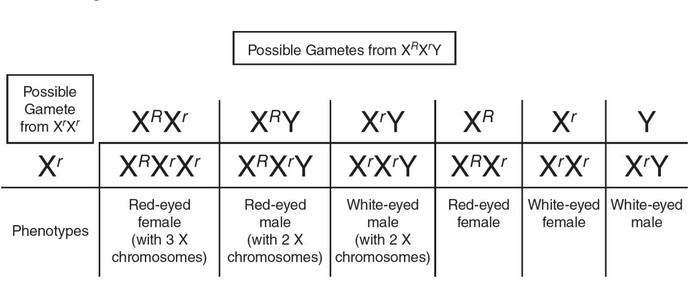Question
Hemophilia is a sex-linked recessive disorder on the X chromosome.
The following figure shows a portion of a pedigree of the descendants of Queen Victoria of England. Individuals with hemophilia are indicated by shading.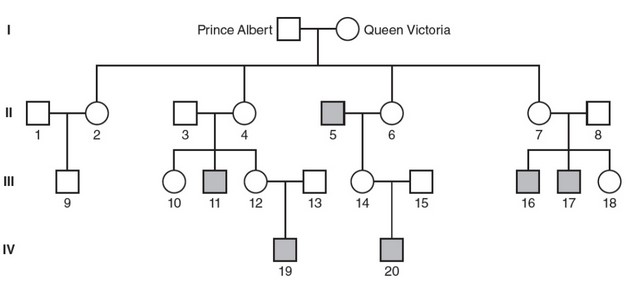
(a) Describe the genotype of individual 4 in generation II. Justify your answer with evidence from the pedigree.
(b) What is the genotype of individual 14 in generation III? Explain how you know her genotype.
(c) Create a Punnett square that represents the possible genotypes of the offspring of individuals 7 and 8 in generation II.
(d) Explain why the offspring of two closely related individuals are more likely to express recessive traits.
▶️Answer/Explanation
Ans:
(a) Individual II-4 is a heterozygous carrier of the hemophilia allele \((X^HX^h)\) because she does not have hemophilia but she does have a male offspring who does have hemophilia.
(b) Individual III-14 is a heterozygous carrier of the hemophilia allele \((X^HX^h)\) because her father has hemophilia and all females inherit an X chromosome from their father. It is also clear that she is a heterozygous carrier because she does not have hemophilia but she does have a male offspring who does have hemophilia.
(c) 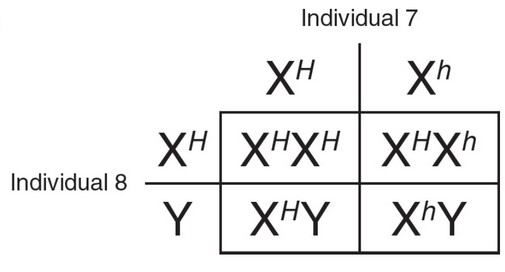
(d) Closely related individuals are more likely to share the same
alleles. If two closely related individuals share the same recessive
alleles, their offspring would be more likely to express that
recessive trait than two individuals who are not as closely related
and do not have the same recessive alleles.
Question
This pedigree shows the inheritance of a trait in three generations of a family.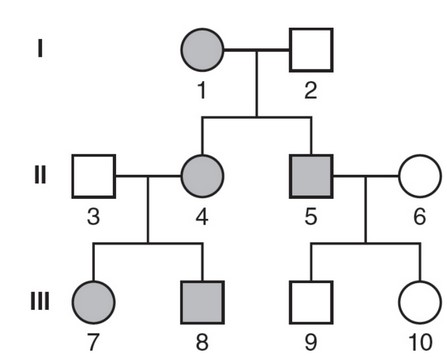
(a) Describe a likely mode of inheritance of this trait. Use evidence from the pedigree to justify your answer.
(b) Explain how a pedigree for a trait that is recessive would look different from a pedigree for a trait that is dominant.
(c) A student makes a claim that this pedigree indicates the trait is inherited through mitochondrial DNA. Evaluate this claim using evidence from the pedigree.
(d) Explain why the pattern of inheritance of an autosomal dominant trait is different from the pattern of inheritance of a mitochondrial trait.
▶️Answer/Explanation
Ans:
(a) Because the trait is expressed in every generation, it could be an
autosomal dominant trait. Since both sexes can express the trait but
only females can pass the trait to the next generation, the mode of
inheritance could be mitochondrial (nonnuclear).
(b) If a trait is dominant, it will usually appear in every generation in a
pedigree. Recessive traits will appear in offspring but do not
necessarily appear in the parents because the parents may be
unaffected heterozygous carriers of the trait.
(c) Mitochondrial DNA is passed on from mother to offspring. The
egg is thousands of times larger than the sperm, so during
fertilization, the zygote inherits its mitochondria from the mother.
Mothers will pass on mitochondrial DNA to all of their offspring,
but their sons will not pass it on to the next generation. This is
exactly what is shown in the three generations of this pedigree.
(d) Autosomal dominant traits can be passed on to the next generation
by either males or females. Mitochondrial traits can only be passed
on to the next generation by females.
Question
In Drosophila (fruit flies), eye color is on the X chromosome. Male flies have an X and a Y chromosome, and female flies have two X chromosomes.
(a) A red-eyed male fly is mated with a white-eyed female fly. All the resulting female offspring have red eyes, and all the resulting male offspring have white eyes. Explain which trait, red eyes or white eyes, is dominant and why. Draw a Punnett square to support your answer.
(b) Scientists have discovered that white-eyed flies have a mutation in the enzyme TRY 2,3-dioxygenase (TDO2). TDO2 mutations prevent the accumulation of kynurenine, a compound associated with aging. White-eyed flies and red-eyed flies were raised under identical conditions, and the mean life span of both type of flies was recorded. Identify the independent variable and the dependent variable in that experiment.
(c) The data from the experiment described in part (b) are shown in the following table.
| Phenotype | Mean Life Span in Days \((\pm 2SEM)\) |
| White-eyed flies | 42.8 \((\pm 5.8)\) |
| Red-eyed flies | 29.1 \((\pm 4.9)\) |
Evaluate the data to determine whether or not there is likely a statistically significant difference in the life spans of white-eyed and red-eyed flies based on this experiment.
(d) A nondisjunction event in meiosis leads to the production of a heterozygous red-eyed male fly with two X chromosomes and one Y chromosome. Predict the possible offspring from a mating between this male and a white-eyed female, and justify your answer.
▶️Answer/Explanation
Ans:
(a) Females inherit one X chromosome from their male parent and one
from their female parent. Since all of the females produced from
the cross have the same phenotype as their male parent (red eyes),
red eyes must be dominant to white eyes. Males inherit their only X
chromosome from their female parent, so all of the males have the
white-eyed phenotype. The results of the cross are shown in the
following figure.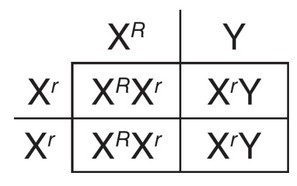
(b) The independent variable is the color of the eyes (or the presence
or absence of the TDO2 mutation). The dependent variable is the
mean life span.
(c) There is likely a statistically significant difference if the 95%
confidence intervals do NOT overlap. The lower limit of the 95%
confidence interval for the mean life span of the white-eyed flies is
37 days (42.8 – 5.8). The upper limit of the 95% confidence interval for the mean life span of the red-eyed flies is 34 days (29.1
+ 4.9). The 95% confidence intervals do not overlap, so there is
likely a statistically significant difference in the life spans of the
two groups of flies in this experiment.
(d) In this mating, \(\frac{2}{3}\) of the females would have red eyes, \(\frac{1}{3}\) of the females would have white eyes, \(\frac{2}{3}\) of the males would have white eyes, and \(\frac{1}{3}\) of the males would have red eyes, as shown in the figure.